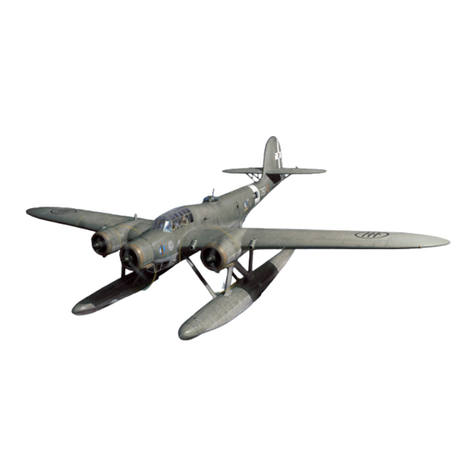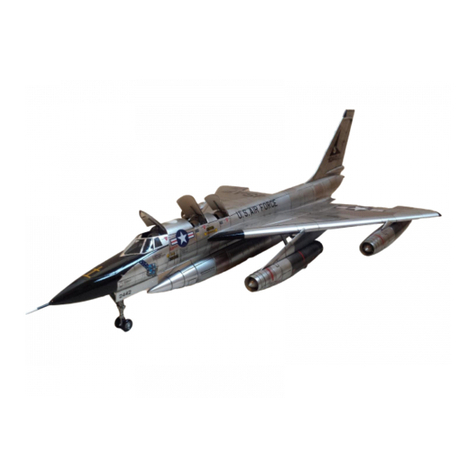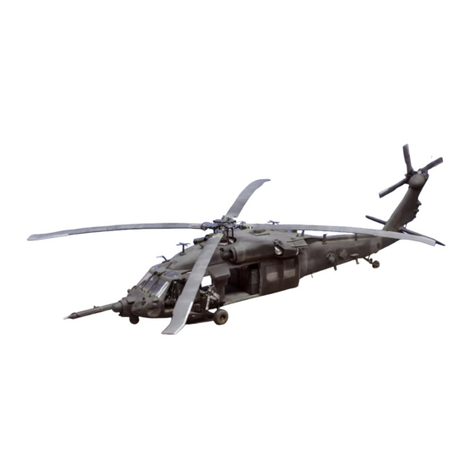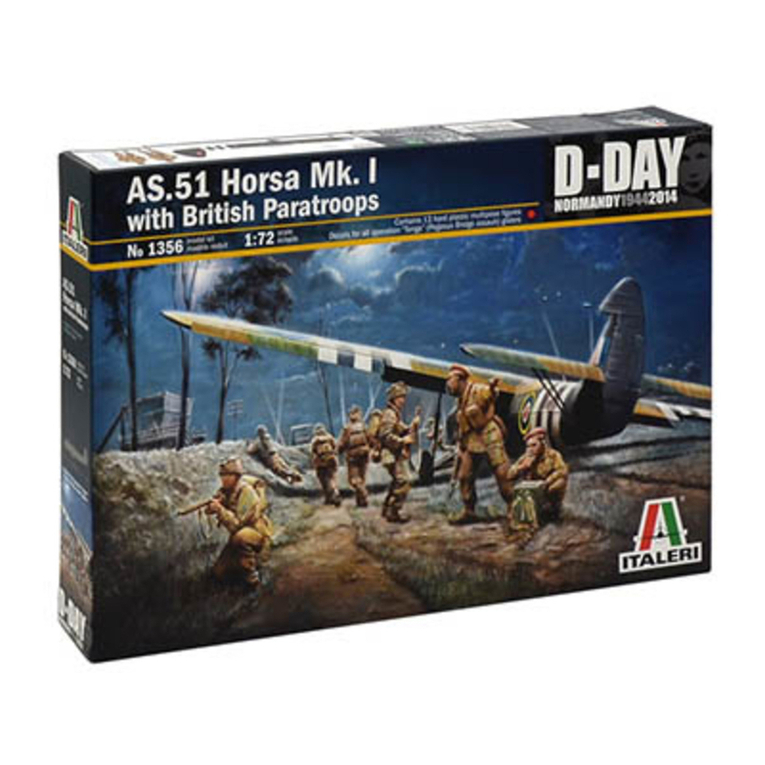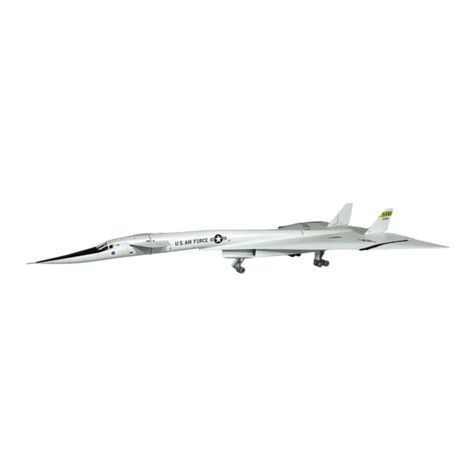
1
Via Pradazzo, 6/b
40012 Calderara di Reno
Bologna - Italy
made in italy
U-BOOT BIBER
“Biber” was the most notorious “poket size” submarine deployed by the Kriegsmarine,
German’s third Reich marine during the end of Second World War. The development of the
Biber was extremely rapid. The design began in February 1944 and first examples were set
to sea only 6 months later. With only 9 meters length, it was capable of a 240 kilometres
range. Able to reach a merged maximum speed of 6,5 notches and 5,3 notches submerged.
The Biber could have been equipped with two 530mm torpedoes mounted externally or with
two mines. The crew consisted of only one member. The deployment of the Biber, within the
Kriegsmarine strategy, was very simple: supply an efficient defence of the cost shore as
protection to a possible, further more probable, Allied invasion. Anyhow, the Biber was never
a serious threat for the Allied. Both due to it’s technical and design defects and for the crew
trained, for war needs, excessively fast and without necessary formation. Nether the less,
from 1944 till the end of the Second World War, the Kriegsmarine took delivery and placed in
operation more then 300 Bibers.
EN
No 5609
1:35
scale
FR
IT
NLDE
ES
Der “Biber” war das bekannteste “Taschenformat”-U-Boot, das die Deutsche Kriegsmarine
zum Ende des zweiten Weltkrieges einsetzte. Die Entwicklung des U-Bootes erfolge extrem
schnell. Der erste Entwurf lag im Februar 1944 vor, die ersten Muster-Exemplare wurden schon
sechs Monate später auf dem Meer erprobt.
Mit nur neun Metern Länge hatte es eine Reichweite von 240 Kilometern. Aufgetaucht
erreichte es eine Höchstgeschwindigkeit von 6,5 Knoten, untergetaucht waren es 5,3 Knoten.
Bewaffnet werden konnte das U-Boot mit zwei 530 mm Torpedos, die außen angebracht wurden,
oder mit zwei Minen. Die Mannschaft bestand aus nut einem Mitglied. Die Anforderungen der
Kriegsmarine an die Entwicklung waren sehr einfach: Man wollte eine Leistungsfähiges Mini-U-
Boot zur Verteidigung der Küsten bei einer erwarteten Alliierten Invasion.
Eine ernste Bedrohung war der „Biber“ für die Alliierten allerdings nicht wirklich.
Entwicklungsfehler sowie die fehlende Ausbildung oder mangelhafte Ausbildung der
Mannschaften verhinderten dies. Dennoch wurden von Ende 1944 bis zum Ende des Krieges
noch 400 Einheiten in Dienst gestellt.
Il “Biber” è stato il più noto sottomarino “tascabile” impiegato durante la fine della Seconda
Guerra Mondiale dalla Kriegsmarine, la marina militare del tedesca del terzo Reich. Lo sviluppo
del Biber fu estremamente rapido. La progettazione iniziò a Febbraio del 1944 ed i primi
esemplari presero il mare solo 6 mesi più tardi. Lungo appena 9 metri era dotato di un’autonomia
di 240 Kilometri. Poteva raggiungere una velocità massima di 6,5 nodi in emersione e 5,3
nodi in immersione. Il Biber poteva essere armato con due siluri da 530 mm., montati esterni
al sottomarino, oppure con due mine. Il suo equipaggio era costituito da una sola persona.
L’impiego del Biber, all’interno della strategia della Kriegsmarine, era molto semplice : fornire
una difesa concreta lungo le coste a protezione di una possibile, e sempre più probabile,
invasione alleata. Il Biber non costituì tuttavia una seria minaccia per gli Alleati, sia a causa di
difetti tecnici e di progettazione, sia a causa degli equipaggi addestrati, per esigenze belliche,
troppo in fretta e senza la dovuta formazione. Nonostante questo, dal 1944 sino alla fine
della Seconda Guerra Mondiale, la Kriegsmarine ha ricevuto e reso operativi più di 300 Biber.
Le “Biber” est le plus connu des “sous-marins de poche” utilisés par la Kriegsmarine, la
marine du 3ème Reich, durant la 2ème Guerre Mondiale. Le développement du Biber fut
extrêmement rapide. Sa conception débuta en février 1944 et les premiers exemplaires
prirent la mer 6 mois plus tard. D’une longueur de 9 mètres seulement, il avait une autonomie
de 240km et pouvait atteindre la vitesse maxi de 6,5 nœuds en immersion et 5,3 nœuds en
surface. Le Biber aurait pu être armé de deux torpilles de 530mm installées à l’extérieur ou
de deux mines. L’équipage se limitait à un seul homme. La mission du Biber était simple :
défendre les côtes lors d’une possible, voire très probable, invasion alliée. Cependant, le Biber
ne constitua jamais une menace sérieuse pour les alliés du fait de ses défauts de conception
et de construction et de l’inexpérience de ses équipages, insuffisamment entrainés pour des
missions de combat. Néanmoins, de 1944 à la fin de la guerre, la Kriegsmarine prit livraison
et utilisa en opération plus de 300 Bibers.
De "Biber" was de meest beruchte vestzak-onderzeeÎr ingezet door de Kriegsmarine, de Duitse
marine van het Derde Rijk, tijdens het einde van de Tweede Wereldoorlog. De ontwikkeling van
de Biber ging zeer snel. Het ontwerp begon in februari 1944 en de eerste prototypes werden
slechts 6 maanden later in gebruik genomen. Met slechts 9 meter lengte had het een bereik
van 240 kilometer en kon op het water een maximale snelheid van 6,5 knopen bereiken en
onder water 5,3 knopen. De Biber kon worden uitgerust met twee extern gemonteerde 530mm
torpedo's of met twee mijnen. De bemanning bestond uit slechts ÈÈn persoon. De inzet van
de Biber, binnen de strategie van de Kriegsmarine, was heel eenvoudig: levering van een
efficiÎnte verdediging tegen een zeer waarschijnlijk geallieerde invasie. Hoe dan ook, de Biber
was nooit een serieuze bedreiging voor de geallieerden, zowel als gevolg van defecten in het
technische ontwerp en gebrek aan opleidingen voor de bemanningen. Desondanks ontving
de Kriegsmarine van 1944 tot het einde van de Tweede Wereldoorlog meer dan 300 Bibers.
El “Biber” fue el submarino de tamaño “bolsillo” más conocido que utilizó la Kriegsmarine
(la armada del Tercer Reich) durante el final del la Segunda Guerra Mundial. El desarrollo del
Biber fue sorprendentemente rápido, ya que su diseñó comenzó en Febrero de 1944 y las
primeras unidades se hicieron a la mar tan sólo 6 meses más tarde. Este pequeño submarino
(sólo medía 9 metros de longitud) tenía una autonomía de 240 kilómetros y era capaz de
alcanzar una velocidad de 6,5 nudos en la superficie y 5,3 cuando estaba sumergido. El
Biber podía equiparse con dos torpedos de 530 mm. que se montaban en el exterior o con 2
minas y su tripulación consistía de un único miembro. El uso de este submarino, dentro de la
estrategia de la Kriegsmarine, era muy simple: defender la costa de las posibles invasiones
Aliadas. Sin embargo, el Biber nunca fue una seria amenaza para las Fuerzas Aliadas debido,
principalmente, a sus defectos técnicos y de diseño y a la poca formación de su tripulación
que fue entrenada demasiado rápido por exigencias de la propia guerra. A pesar de todo
esto, desde 1944 hasta el final de la Segunda Guerra Mundial, la Kriegsmarine utilizó más
de 300 Bibers.
ATTENTION - Useful advice!
Study the instructions carefully prior to assembly. Remove parts from frame with a sharp knife or a
pair of scissor and trim away excess plastic. Do not pull ol parts. Assemble the parts in numerical
sequence. Use plastlc cement ONLY and use cement sparingly to avoid damaging the model. Black
arrows indicate parts to be glued together. White arrows indicate on which frame the parts must be
assembled WITHOUT using cement. These letters (A -B - C…) indicate on which frame the parts will
be found. Paint small parts before detaching them from frame. Remove paint-where parts are to be
cemented. Crossed out parts must not be used.
ATTENZIONE - Consigli utlili!
Prima di iniziare il montaggio studiare attentamente il disegno. Staccare con molta cura i pezzi dalle
stampate, usando un taglia-balsa oppure un paio di forbici e togliere con una piccola lima o con carta
vetro fine eventuali sbavature. Mai staccare i pezzl con le mani. Montarli seguendo l’ordine delle
numerazione delle tavole. Eliminare dalla stampata il numero del pezzo appena montato facendogli
sopra una croce. Le frecce nere indicano i pezzi da incollare, le frecce bianche indicano i pezzi da
montare senza colla. Usare solo colla per polistirolo. Le lettere (A - B - C…) ai lati dei numeri indicano
la stampata ove si trova il pezzo da montare. I pezzl sbarrati da una croce non sono da utilizzare.
ACHTUNG - Ein nützlicher Rat!
Vor der Montage die Zeichnung aufmerksam studieren. Die einzeinen Montageteile mit einem Messer
oder einer Schere vom Spritzling sorfälling entfernen. Eventuelle Grate werden mit eicer Klinge oder
feinem Schmirgelpapier beseitigt. Keinesfalls die Montageteile mit den Händen entfernen. Bei der
Montage der Tafelnumerieung folgen. Pfeile zeigen die zu klebenden Teile während die weissen Pfeile
die ohne Leim zu montierenden Teile anzeigen. Bitte nur Plastikklebstoff verwenden. Die Buchstaben
(A - B - C…) neben den Nummeren zeigt,auf welchem Spritzling der zu montierende Tèil zu finden ist.
Die mit einem Kreuz markierten Teile sind nicht zu verwenden.
ATTENTION - Conseils utiles!
Avant de commencer le montage, étudier attentivement le dessin. Détacher avec beacoup de soin les morceaux
des moules en usant un massicot ou bien un pair de cisaux et couper avec une petite lame avec de papier de
vitre fin ébarbagés eventuels. Jamais détacher les morceaux avec le mains Monter les en suivant l’ordre de la
numération des tables. Eliminer de la moule le numéro de la pièce qui vient d’être montée, en le biffant avec une
croix. Les fléches noires indiquent les pièces à coller, les fléches blanches indiquent les pièces à monter sans
colle. Employer seulement de la colle pour polystirol. Les lettres (A - B - C…) aux côtés des numéros indiquent
la moule où se trouve la pièces a monter. Les pièces marquèes par une croix ne sont pas a utiliser.
OPGELET - Belangrijke bemerkingen!
Bestudeer zorgvuldig het montageplan voor het bouwen. Breek nooit onderdelen van het kader. Maak
ze los met een scherp mes of kleine nageltang. Verwijder daarna al het overtollige plastic en pas de
delen alvoorens te lijmen. Gebruik allen lijm voor plastic modellen. Werk zorgvuldig en spaarzaam,
teveel Iijm zal uw model beschadigen. Zwarte pijlen duiden de te lijmen delen aan. Witte pijlen ver-
wijzen naar bewegende delen welke niet mogen worden gelijmd. Deze letters (A - B - C…) geven de
kaders aan waarin de onderdelen zich bevinden. Schilder de kleine onderdelen voor ze van het kader
te snijden. Verwijder de verf van de te lijmen opperviakten.
ATENCION - Consejos útiles!
Estudiar las instrucciones cuidadosamente antes de comenzar el montaje. Separar las piezas de
las bandejas con un cuchillo afilado o un par de tijeras y retirar el exceso de plástico o rebada. No
arrancar las piezes. Montar las piezas en orden numérico. Utilizar SOLAMENTE pegamento para
plástico y en poca cantidad para evitar que se dane el modelo. Las flechas negras indican las piezas
que se deben pegar juntas. Las flechas blancas indican las piezas que deben ensamblarse SIN
usar pegamento. Las letras (A - B - C…) indican en que bándeja se encuentran las piezas. Pintar
las piezas pequeñas antes de separarlas de la bandeja. Retirar la pintura de los lugares por donde
se deban pegar las piezas.
EN
IT
DE
FR
NL
ES
Conservare il presente
indirizzo per futuro
riferimento
Retain this address
for future
reference
NL WAARSCHWING: Geschikt voor 14 jaar en ouder.
EN WARNING: Model for adult collector age 14 and over
IT ATTENZIONE: Modello per collezionisti adulti di età superiore ai 14 anni
FR ATTENTION: Modèle pour modélistes de 14 and et plus.
DE ACHTUNG: Modellbausatze Für Modellbauer über 14 Jahre.
ES ATENCION: Modelo para modelistas mayors de 14 anõs.
5609_FI.indd 8 22/07/2010 14.22.45
